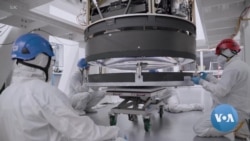ໃນລັດຄາລິຟໍເນຍ, ກ້ອງຖ່າຍຮູບຂະຫນາດເທົ່າກັນກັບລົດຄັນນຶ່ງ ກໍາລັງຖືກ ກະກຽມອອກປະຕິບັດພາລະກິດຂອງຕົນ ນັ້ນກໍຄື ການບັນທຶກປາກົດການທີ່ບໍ່ເຄີຍໄດ້ ເຫັນ ຢູ່ໃນຈັກກະວານ. Matt Dibble ມີລາຍງານກ່ຽວກັບເລື່ອງນີ້ ຊຶ່ງບົວສະຫວັນ ຈະນຳມາສະເໜີທ່ານໃນອັນດັບຕໍ່ໄປ..
ຢູ່ທີ່ຫ້ອງທົດລອງແບບເລັ່ງລັດ ຫລືສແລັກ (SLAC) ໃນເມືອງເມນໂລ ພາກ (Menlo Park) ຂອງລັດຄາລິຟໍເນຍນັ້ນ ພວກນັກວິສະວະກອນ ກໍາລັງສ້າງກ້ອງຖ່າຍຮູບດິຈິຕອລທີ່ ໃຫຍ່ທີ່ສຸດຂອງໂລກ. ກ້ອງທີ່ຖືກເອີ້ນວ່າ LSST ຈະຖືກຕິດຕັ້ງຢູ່ຫໍຄອຍຊົມດາວ ເວຣາ ຊີ. ຣຸບບິນ (Vera C. Rubin) ໃນພາກໃຕ້ຂອງປະເທດຊີເລ ເພື່ອບັນທຶກຮູບພາບຂອງທ້ອງຟ້າໃນຕອນກາງຄືນ ໃນໄລຍະສິບປີ.
ໂດຍການສັງເກດເບິ່ງຂອບເຂດອັນກວ້າງໃຫຍ່ ຂອງຈັກກະວານຕະຫຼອດເວລາ, ພວກນັກຄົ້ນຄວ້າຄາດວ່າ ຈະໄດ້ຮັບຄວາມເຂົ້າໃຈ ຕໍ່ຂໍ້ຂ້ອງໃຈທີ່ຍິ່ງໃຫຍ່ທີ່ສຸດຈຳນວນນຶ່ງຂອງວິທະຍາສາດ.
ນັກສຶກສາປະລິນຍາເອກ, ແທວ ຊຸດ (Theo Schutt) ກໍາລັງທຳລອງກວດສອບ ເບິ່ງກ້ອງຖ່າຍຮູບຂັ້ນສຸດທ້າຍ.
ນາງແທວ ຊຸດ (Theo Schutt), ນັກສຶກສາປະລິນຍາເອກຂອງມະຫາວິທະຍາໄລ ສແຕນຝອດ (Stanford) ເວົ້າວ່າ: “ຈັກກະວານມີອາຍຸຫລາຍປານໃດ, ມັນຂະຫຍາຍໄວປານໃດ, ເປັນຫຍັງມັນຈຶ່ງຂະ ຫຍາຍອອກໄປ? ສະນັ້ນ ພວກເຮົາກໍຢາກໄປຊອກຫາ 95 ເປີເຊັນ ຂອງຈັກກະ ວານທີ່ໂດຍພື້ນຖານແລ້ວ ພວກເຮົາບໍ່ເຂົ້າໃຈແທ້ໆເລີຍ."
ພວກນັກວິທະຍາສາດ ໃຫ້ຄຳເຫັນໃນທາງທິດສະດີວ່າ 95 ເປີເຊັນ ຂອງຈັກກະວານ ແມ່ນປະກອບດ້ວຍພະລັງງານມືດ ແລະ ສິ່ງທີ່ມືດ, ເຊິ່ງບໍ່ສາມາດເຫັນໄດ້ໂດຍກົງ.
ແຕ່ຢ່າງໃດກໍຕາມ, ຜົນກະທົບທີ່ພະລັງງານມືດມີຕໍ່ສິ່ງອ້ອມຂ້າງຂອງມັນອາດສາມາດ ກວດພົບໄດ້ ຖ້າຫາກມີການສັງເກດຢູ່ຕະຫລອດເວລາ.
ທ່ານແອຣອນ ຣູດແມນ (Aaron Roodman), ນັກວັດຖຸວິທະຍາດ້ານດາລາສາດ, ເປັນຜູ້ນໍາພາໂຄງການກ້ອງຖ່າຍຮູບ.
ທ່ານແອຣອນ ຣູດແມນ (Aaron Roodman), ຮອງຜູ້ອໍານວຍການຫໍຄອຍຊົມດາວ ຣຸບບິນ ກ່າວວ່າ: "ພວກເຮົາສາມາດສຶກສາຄົ້ນຄວ້າມັນໄດ້ ໂດຍການເບິ່ງກຸ່ມດາວກາແລັກຊີ (galaxy), ໂດຍການສຶກສາວ່າ ແສງສະຫວ່າງຈາກກຸ່ມດາວກາແລັກຊີທີ່ຢູ່ຫ່າງໄກ ໄດ້ຖືກເຮັດໃຫ້ມັນຫັນເຫອອກ ໂດຍສິ່ງທັງໝົດ ທີ່ຢູ່ລະຫວ່າງພວກເຮົາ ແລະກຸ່ມດາວກາແລັກຊີ ທີ່ ຢູ່ຫ່າງໄກໄດ້ແນວໃດ."
ກ້ອງຖ່າຍຮູບຈະບັນທຶກໃນເກືອບທຸກຄືນ, ໂດຍພື້ນຖານແລ້ວ ແມ່ນຮວບຮວມເອົາ ຮູບເງົາທີ່ມີເວລາເຫຼື່ອມກັນ. ແຕ່ລະຮູບ ຈະປະກອບມີປະມານ 3 ຕື້ ພິກໂຊລ (pixel) ຊຶ່ງປະມານ 300 ເທົ່າຂອງຂະຫນາດຮູບທີ່ຖ່າຍດ້ວຍໂທລະສັບສະຫຼາດ ຫລື smartphone.
ໂດຍໄດ້ຮັບທຶນຈາກລັດຖະບານສະຫະລັດ ໂຄງການດັ່ງກ່າວ ຈະແບ່ງປັນຮູບພາບໃຫ້ພວກນັກຄົ້ນຄວ້າສາກົນໄດ້ເຫັນນຳ, ໂດຍໄດ້ຊີ້ທິດທາງໃຫ້ຫັນຄວາມສົນໃຈ ໄປຫາປາກົດການ ທີ່ເກີດຂຶ້ນໃນໄລຍະສັ້ນໆ ໃນຂະນະທີ່ມັນພວມເກີດຂຶ້ນນັ້ນ.
ທ່ານຣູດແມນ ກ່າວຕໍ່ໄປວ່າ: "ພາຍໃນສອງນາທີ, ພວກເຮົາຈະປຽບທຽບວັດຖຸທີ່ພວກເຮົາເຫັນຢູ່ໃນນັ້ນ - ຄືດວງ ດາວ, ກຸ່ມດາວກາແລັກຊີ, ດາວພະເຄາະນ້ອຍ - ໃສ່ກັນກັບຮູບຮ່າງທີ່ພວກມັນປາ ກົດຢູ່ໃນຮູບພາບກ່ອນຫນ້ານັ້ນ. ແລະພວກເຮົາຈະໝາຍເຄື່ອງໝາຍໃສ່ ບ່ອນທີ່ມັນ ແຕກຕ່າງກັນ.”
ພວກນັກຄົ້ນຄວ້າກຳລັງຄອງຄອຍຖ້າດ້ວຍໃຈຈົດຈໍ່ ທີ່ຈະໄດ້ເຫັນສິ່ງທີ່ບໍ່ຄາດຝັນວ່າຈະໄດ້ເຫັນ.
ອ່ານຂ່າວນີ້ເພີ້ມເປັນພາສາອັງກິດຢູ່ລຸ່ມນີ້:
In California, a camera the size of a car is being prepared for its mission: documenting unseen phenomena in the universe. Matt Dibble has the story.
At the SLAC National Accelerator Laboratory in Menlo Park, California
engineers are building the world’s largest digital camera. The LSST camera, as it’s called, will be installed at the Vera C. Rubin Observatory in southern Chile to record images of the night sky over a ten-year period.
By observing a wide swath of the universe over time, researchers expect to gain insight into some of science’s biggest questions.
PhD student Theo Schutt is running final tests on the camera.
Theo Schutt, Stanford University Ph.D Student: “How old is the universe, how fast is it expanding, why is it expanding?
So we're really like going for the 95% of the universe that we basically don't understand at all.”
Scientists theorize that 95% of the universe is made up of dark energy and dark matter, which can’t be seen directly.
However, the effect that dark energy has on its surroundings can potentially be detected if observed over time.
says astrophysicist Aaron Roodman, who leads the camera project.
Aaron Roodman, Rubin Observatory Deputy Director:
“We can study it by looking at galaxies, studying how the light from distant galaxies has been bent by all the matter between us and the distant galaxy.”
The camera will record on most nights, essentially compiling a time-lapse movie.
Each image will be made up of about 3 billion pixels about 300 times the size of a smartphone image.
Funded by the US government, the project will share images with international researchers, directing attention to short-lived phenomena as they happen.
Aaron Roodman, Rubin Observatory Deputy Director:
“Within two minutes, we will compare the objects we see in it — the stars, galaxies, asteroids — with how they previously appeared in prior images. And we will flag any differences.”
Researchers are eagerly expecting the unexpected.





